Micropia museum of invisible life
Getting off the tram with my son and daughter, my first indication that we were nearing our destination, Micropia Museum, was an arrow on a building with the text “only 80,000,000 micrometers to Micropia.”
Micropia, a new exhibit at the ARTIS zoo in Amsterdam, bills itself as “the world’s first museum of microbes.”
Disclosure: This post contains affiliate links. That means I’ll receive a small commission on anything you buy through clicking the links. This will not affect your price.

It’s quite a trick, when you think about it. Most microbes are invisible to the human eye. So how can you build a whole exhibition around them?
What Micropia does is use interactive exhibits, mostly involving large powerful microscopes, combined with multimedia demonstrations.
After a brief explanation by an employee dressed in a lab coat, we were ushered onto a dark elevator, where a projection on the ceiling introduces the subject. Emerging from the elevator brought us into a large dark room where another employee explained quickly how to use the microscopes. Then we were free to move through the exhibits at our own pace.
Observing microbes at Micropia Museum
Generally the displays are arranged from smallest to largest. Many centered around a particular organism using a large microscope. We were able to observe the algae or bacteria or plankton or whatever in several ways.
First of all each was visible in a large, dramatically lit flask. When I say “visible” here, it often wasn’t actually visible. The flask with green algae just looked like green water. The water fleas looked like tiny flecks moving about.
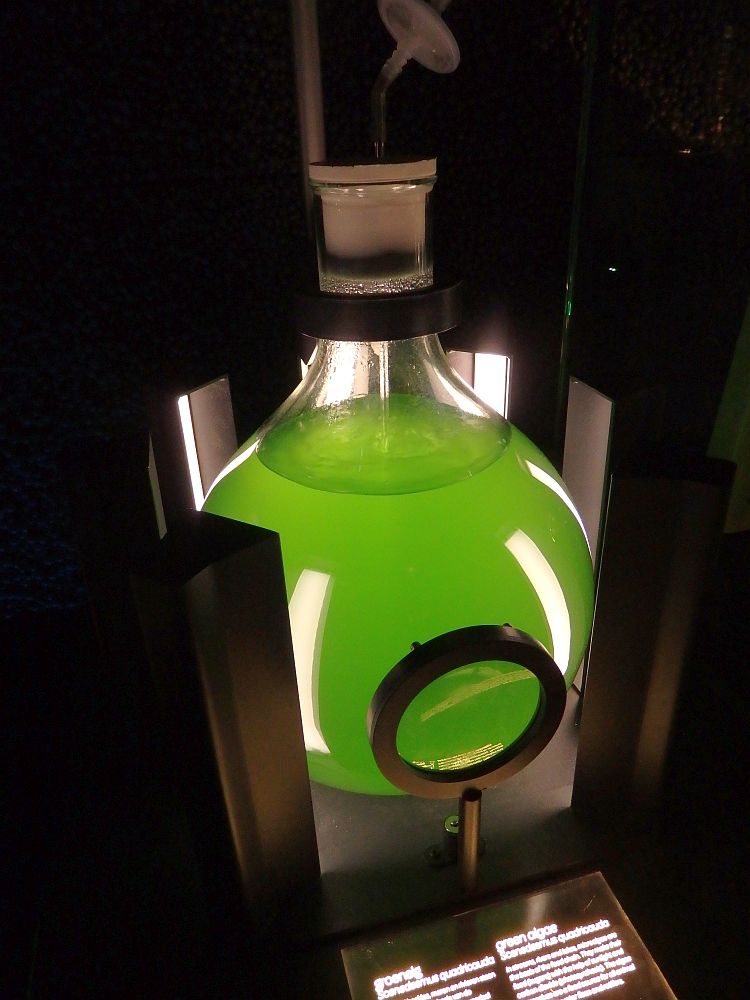
Second, we could look in the microscope. We were able to move the slide (visible on the microscope inside a glass case) and zoom in or out to sharpen the view.
Third, whoever wasn’t using the microscope could see the same image on a screen set into a table next to the microscope.
This struck me as an efficient way to manage the situation: no one would be stuck waiting for a microscope, since several people could see that large image at the same time.
Buy your skip-the-line tickets to Micropia here.
Microbes and the human body
Besides the microscope exhibits, the designers of Micropia Museum made sure to connect the information about microbes to humans. One display was two large interactive screens. Standing in front of them, our bodies were, at least in simulation, scanned. We could wave our arms to choose different parts of the body. Point to your stomach, for instance, and the display shows and tells what sorts of microbes live there and what they do.

Did you know that you have 80 different sorts of fungi on the heels of your feet, about 40 more between your toes, 60 on your toenails, 30 on your hands and ten in your nose? That’s the sort of information you get at this display. It made me want to go home and take a shower.
Check out my series on small museums and other sights to see in Amsterdam.
Extreme environments and microbes
In a small curtained-off room, a video projection takes viewers to places around the world with extreme conditions: the hot springs at Yellowstone National Park, for example, or the bottom of an oil well, or inside the Chernobyl nuclear power plant. The screen shows the data – temperature, radiation, acidity, pressure, etc. – and explains exactly what would happen to a human in that environment. The heroes of the story are the microbes, because certain ones thrive in each of these places.
At one end of the dark hall is a well-lit laboratory behind glass. We could watch scientists at work, preparing samples for the Micropia exhibits, and a sign explained each piece of equipment around the lab. It was a bit zoo-like, looking in at the humans, I must say.
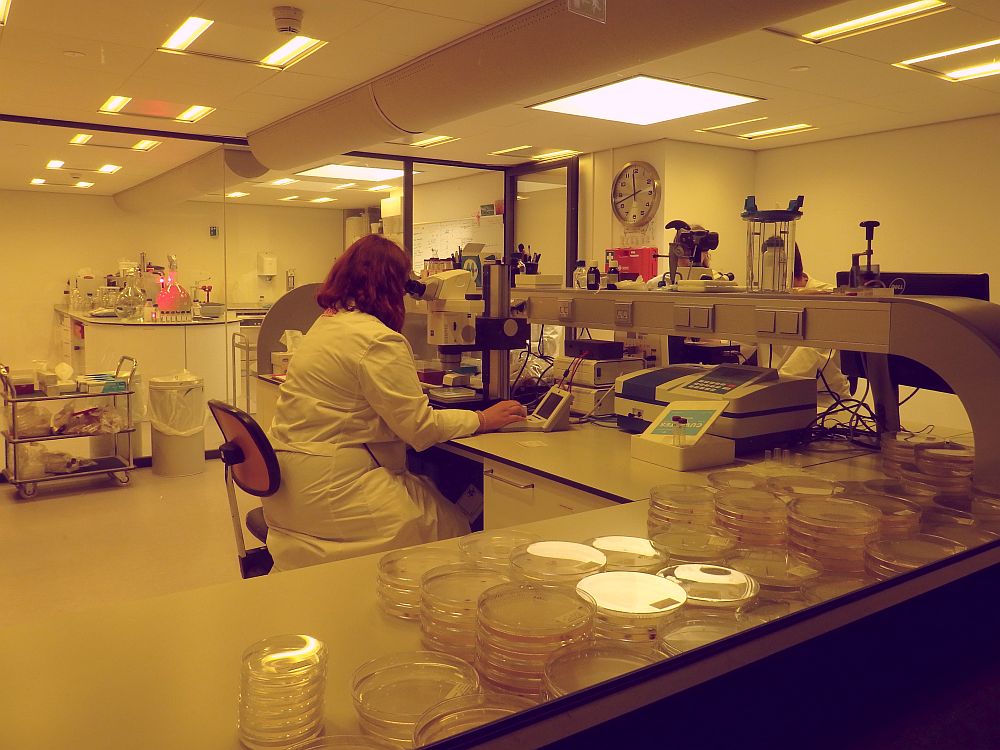
Excrement and death and microbial growth
Another section that emphasized the usefulness of microbes had to do with poop and death. We could examine a case full of bottled excrement from a range of creatures. Next to it, an actual human digestive system – with no explanation of where they got it from, if it is real. The point is that microbes help us in digestion.
A rather disturbing display holds a dead baby giraffe, which apparently died in the zoo next door soon after birth. Because no visible scavengers had access to it – creatures like ants or vultures – the giraffe’s outer shell is intact. The microbes decomposed the insides of the giraffe, leaving the hide intact but wrinkled. A sign beside the display explains how microbes contribute to the necessary recycling that happens with decomposition of dead animals. It emphasizes how necessary this is for life.
A long case holds petri dishes, each carefully labeled, showing microbial growth on various items. One dish, for example, shows what grew after a child’s dirty hand touched it. Another dish shows what grew after a child’s clean hand touched it. There’s not much difference between the two. (And that made me want to go wash my hands!)
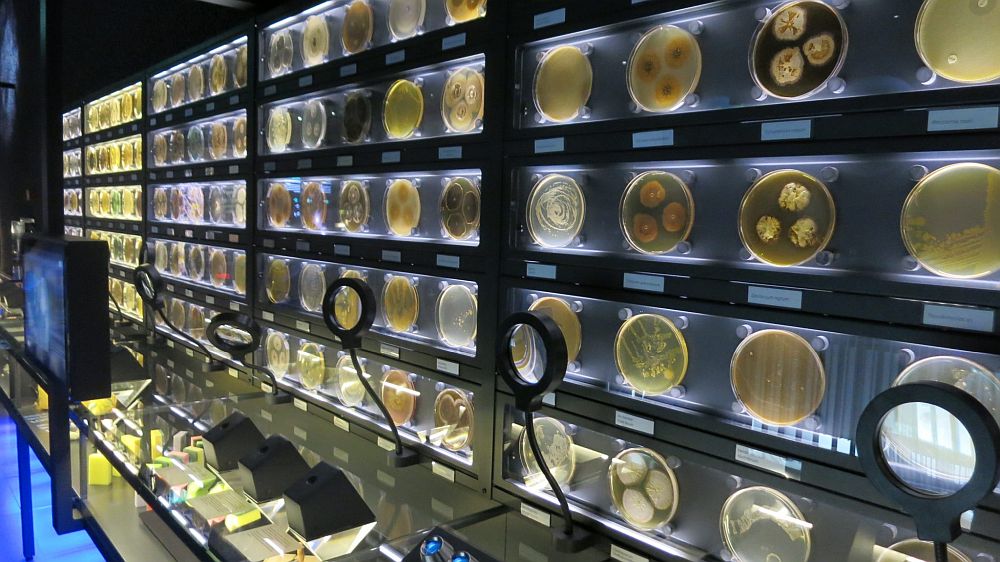
Downstairs at Micropia Museum: decay and disease
Once we had studied all the exhibits upstairs – and my son, who is planning to study biology at university next year, pronounced it good – we went downstairs to see the last section of the exhibition.
This light-filled floor, like the dark room upstairs, held large displays of glass jars. This time, though, they didn’t hold excrement. Instead, each jar held a different sort of human food. Each was labeled with a date, and they had been simply left to decay.
A tomato, only in the jar for a week or so, was covered in a white fur of mold. The mold on the Gouda cheese was similar, but its “fur” was shorter. The cream pie, several weeks older, had disintegrated into an unidentifiable green and white pile. I could go on, but I’ll just say that it was disgusting and yet, at the same time, strangely compelling.
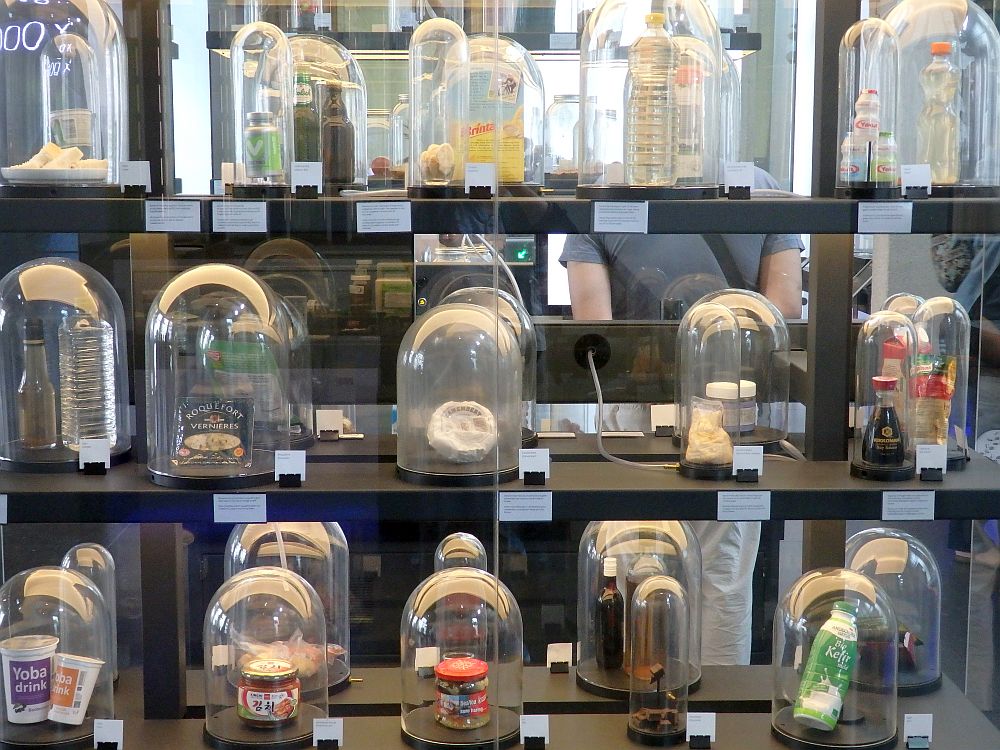
A row of cabinets along one wall addressed diseases caused by microbes: malaria, ebola, AIDS, etc. Each held photos and explanations about one disease. Perched on top of the cabinets was a glass artist’s representation of these deadly microbes.
I had noticed this upstairs as well: microbes can be strangely beautiful, even when they are dangerous.
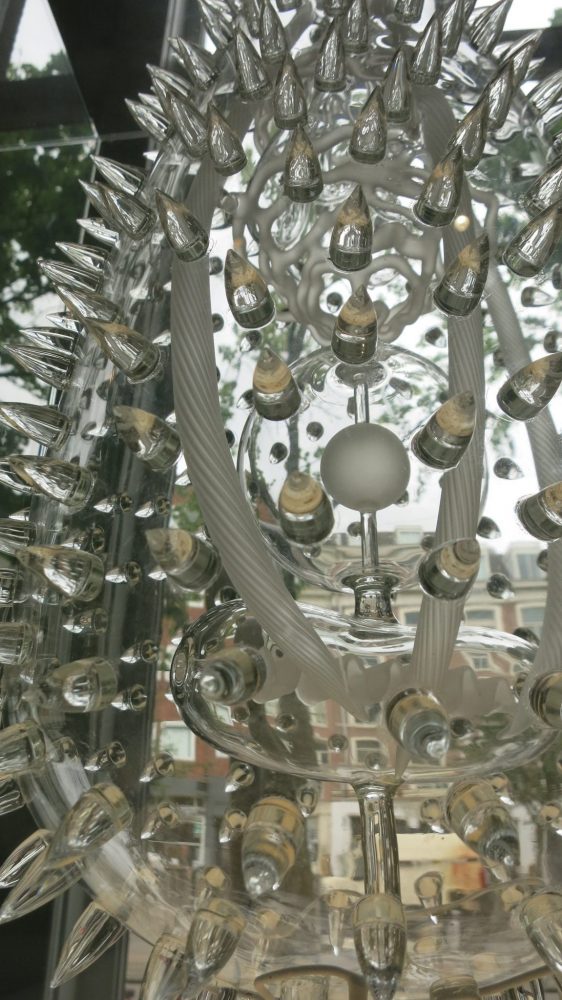
All three of us found Micropia Museum to be interesting and well-presented, especially given the small size of the subject. We had plenty to look at and do because many displays required some action rather than just passive observation.
Except perhaps for the section about death, I think it would be fun and interesting for children as well. They’d enjoy the part about the human body, the petri dishes and the rotting food the best, of course, and there’s enough variety of activities to keep their attention for at least an hour, I’d say. We spent more like an hour and a half there. If you combine it with the zoo, expect to spend the whole day.
Visiting Micropia
To skip the line, click here to buy tickets.
To buy tickets to Artis Zoo, use this link.
Micropia Museum: Plantage Kerklaan 38-40 (inside the entrance to Artis Zoo). Open daily 10:00-17:00. Prices: Age 13 and up €17.50, younger children free. Website.
NOTE: If you are going to visit several museums and attractions on your trip to Amsterdam, it might be worth your while to buy the I AMsterdam City Card. It includes admission to a whole list of museums, sights and entertainment in and outside of Amsterdam, plus a canal boat trip and unlimited public transportation. Use the form below:
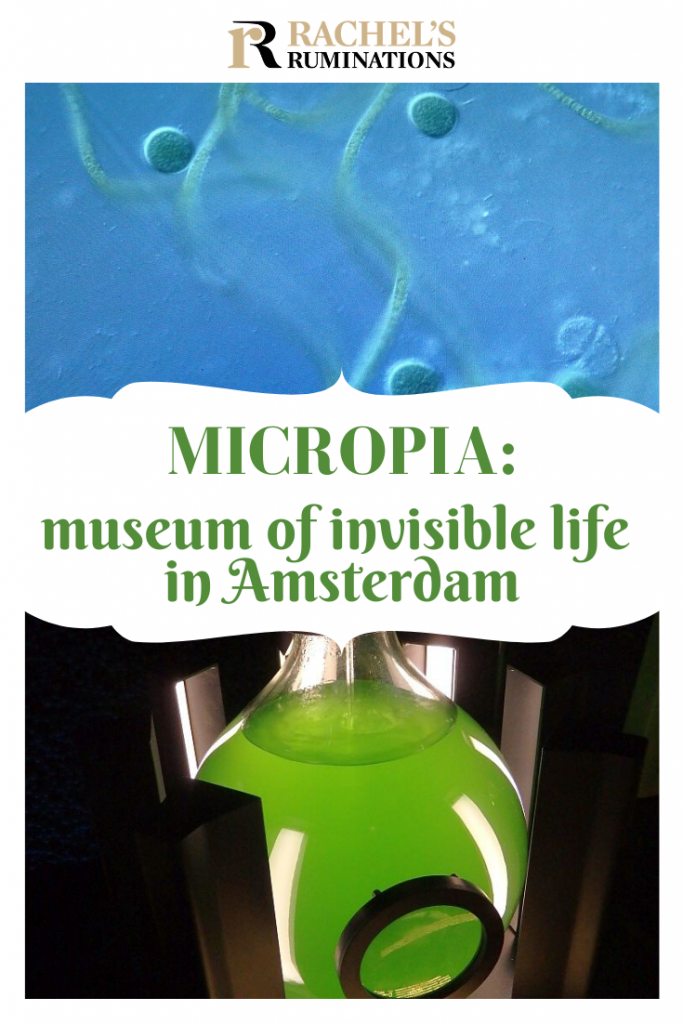
(Last updated May 20, 2024)
My travel recommendations
Planning travel
- Skyscanner is where I always start my flight searches.
- Booking.com is the company I use most for finding accommodations. If you prefer, Expedia offers more or less the same.
- Discover Cars offers an easy way to compare prices from all of the major car-rental companies in one place.
- Use Viator or GetYourGuide to find walking tours, day tours, airport pickups, city cards, tickets and whatever else you need at your destination.
- Bookmundi is great when you’re looking for a longer tour of a few days to a few weeks, private or with a group, pretty much anywhere in the world. Lots of different tour companies list their tours here, so you can comparison shop.
- GetTransfer is the place to book your airport-to-hotel transfers (and vice-versa). It’s so reassuring to have this all set up and paid for ahead of time, rather than having to make decisions after a long, tiring flight!
- Buy a GoCity Pass when you’re planning to do a lot of sightseeing on a city trip. It can save you a lot on admissions to museums and other attractions in big cities like New York and Amsterdam.
- Ferryhopper is a convenient way to book ferries ahead of time. They cover ferry bookings in 33 different countries at last count.
Other travel-related items
- It’s really awkward to have to rely on WIFI when you travel overseas. I’ve tried several e-sim cards, and GigSky’s e-sim was the one that was easiest to activate and use. You buy it through their app and activate it when you need it. Use the code RACHEL10 to get a 10% discount!
- Another option I just recently tried for the first time is a portable wifi modem by WifiCandy. It supports up to 8 devices and you just carry it along in your pocket or bag! If you’re traveling with a family or group, it might end up cheaper to use than an e-sim. Use the code RACHELSRUMINATIONS for a 10% discount.
- I’m a fan of SCOTTeVEST’s jackets and vests because when I wear one, I don’t have to carry a handbag. I feel like all my stuff is safer when I travel because it’s in inside pockets close to my body.
- I use ExpressVPN on my phone and laptop when I travel. It keeps me safe from hackers when I use public or hotel wifi.


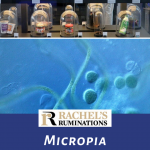
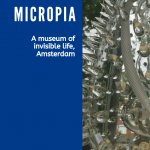
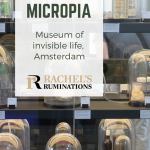
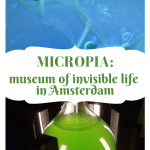

What a great tour sign: 80 million micrometers … ! I loved my microbiology classes in college and, even though it’s way outside of the usual must sees in Amsterdam, I’d put the Micropia museum on my list. It sounds fascinating and I can see its appeal to older school age children. I think the most fascinating exhibit would be the microbes that inhabit the human body but the microbes causing deadly diseases might be a close second. Definitely a unique museum! Anita
This one only opened relatively recently, so it’s not very well-known. I only found out about it because I saw an ad at the airport. And I think people think it’s part of the zoo, so they’d have to make a whole day of it, but it’s not. You can buy a separate ticket or combined.
What an interesting and unusual museum. We don;t generally think much about microbes, but I bet you do more now after visiting this museum.
Yep! And I’m washing my hands even more than I used to!
You do manage to find some interesting museums! I’d love to see the display of all my own microbes and fungi – sounds fascinating.
I still have more to visit to see them all! The funeral museum and the pianola museum are next on the list, I think!
Now I have to go wash my hands too! Micropia sounds like a great addition to a traditional zoo. My husband is a medical researcher and hangs out in a lab, so I think he’d be fascinated. I think I better start insisting that he wash his hands — again —when he gets home from work.
If you ever want to visit a maximum gross out museum, I recommend the Mutter Museum in Philadelphia.
What a fascinating idea for a museum! A micro museum of small museums!